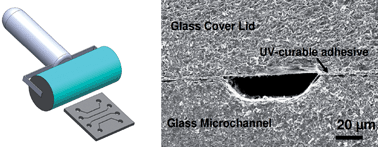Low-temperature, simple and fast integration technique of microfluidic chips by using a UV-curable adhesive†
Abstract
In the fields of MicroElectroMechanical Systems (MEMS) and Lab On a Chip (

* Corresponding authors
a
BIOS, The Lab-on-a-Chip Group, MESA+ Institute for Nanotechnology, University of Twente, Postbus 217, Enschede, The Netherlands
E-mail:
a.vandenberg@utwente.nl
Fax: +31 534893595
Tel: +31 534892691
In the fields of MicroElectroMechanical Systems (MEMS) and Lab On a Chip (

 Please wait while we load your content...
Something went wrong. Try again?
Please wait while we load your content...
Something went wrong. Try again?
R. Arayanarakool, S. Le Gac and A. van den Berg, Lab Chip, 2010, 10, 2115 DOI: 10.1039/C004436A
To request permission to reproduce material from this article, please go to the Copyright Clearance Center request page.
If you are an author contributing to an RSC publication, you do not need to request permission provided correct acknowledgement is given.
If you are the author of this article, you do not need to request permission to reproduce figures and diagrams provided correct acknowledgement is given. If you want to reproduce the whole article in a third-party publication (excluding your thesis/dissertation for which permission is not required) please go to the Copyright Clearance Center request page.
Read more about how to correctly acknowledge RSC content.
 Fetching data from CrossRef.
Fetching data from CrossRef.
This may take some time to load.
Loading related content
